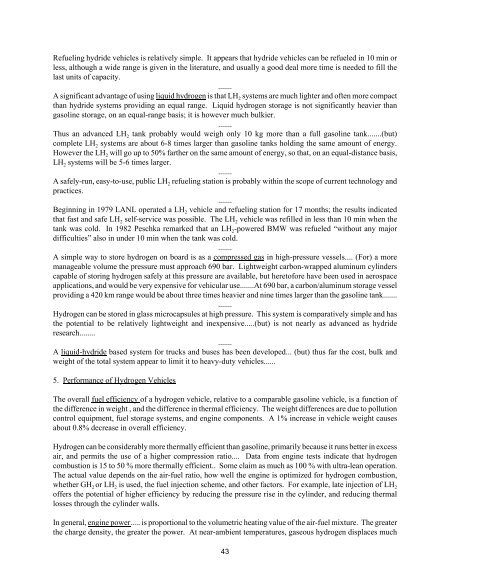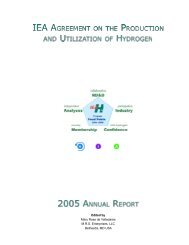Technology Status of Hydrogen Road Vehicles
Technology Status of Hydrogen Road Vehicles
Technology Status of Hydrogen Road Vehicles
Create successful ePaper yourself
Turn your PDF publications into a flip-book with our unique Google optimized e-Paper software.
Refueling hydride vehicles is relatively simple. It appears that hydride vehicles can be refueled in 10 min or<br />
less, although a wide range is given in the literature, and usually a good deal more time is needed to fill the<br />
last units <strong>of</strong> capacity.<br />
.......<br />
A significant advantage <strong>of</strong> using liquid hydrogen is that LH 2 systems are much lighter and <strong>of</strong>ten more compact<br />
than hydride systems providing an equal range. Liquid hydrogen storage is not significantly heavier than<br />
gasoline storage, on an equal-range basis; it is however much bulkier.<br />
.......<br />
Thus an advanced LH 2 tank probably would weigh only 10 kg more than a full gasoline tank.......(but)<br />
complete LH 2 systems are about 6-8 times larger than gasoline tanks holding the same amount <strong>of</strong> energy.<br />
However the LH 2 will go up to 50% farther on the same amount <strong>of</strong> energy, so that, on an equal-distance basis,<br />
LH 2 systems will be 5-6 times larger.<br />
.......<br />
A safely-run, easy-to-use, public LH 2 refueling station is probably within the scope <strong>of</strong> current technology and<br />
practices.<br />
.......<br />
Beginning in 1979 LANL operated a LH 2 vehicle and refueling station for 17 months; the results indicated<br />
that fast and safe LH 2 self-service was possible. The LH 2 vehicle was refilled in less than 10 min when the<br />
tank was cold. In 1982 Peschka remarked that an LH 2-powered BMW was refueled “without any major<br />
difficulties” also in under 10 min when the tank was cold.<br />
.......<br />
A simple way to store hydrogen on board is as a compressed gas in high-pressure vessels.... (For) a more<br />
manageable volume the pressure must approach 690 bar. Lightweight carbon-wrapped aluminum cylinders<br />
capable <strong>of</strong> storing hydrogen safely at this pressure are available, but heret<strong>of</strong>ore have been used in aerospace<br />
applications, and would be very expensive for vehicular use.......At 690 bar, a carbon/aluminum storage vessel<br />
providing a 420 km range would be about three times heavier and nine times larger than the gasoline tank.......<br />
.......<br />
<strong>Hydrogen</strong> can be stored in glass microcapsules at high pressure. This system is comparatively simple and has<br />
the potential to be relatively lightweight and inexpensive.....(but) is not nearly as advanced as hydride<br />
research........<br />
.......<br />
A liquid-hydride based system for trucks and buses has been developed... (but) thus far the cost, bulk and<br />
weight <strong>of</strong> the total system appear to limit it to heavy-duty vehicles......<br />
5. Performance <strong>of</strong> <strong>Hydrogen</strong> <strong>Vehicles</strong><br />
The overall fuel efficiency <strong>of</strong> a hydrogen vehicle, relative to a comparable gasoline vehicle, is a function <strong>of</strong><br />
the difference in weight , and the difference in thermal efficiency. The weight differences are due to pollution<br />
control equipment, fuel storage systems, and engine components. A 1% increase in vehicle weight causes<br />
about 0.8% decrease in overall efficiency.<br />
<strong>Hydrogen</strong> can be considerably more thermally efficient than gasoline, primarily because it runs better in excess<br />
air, and permits the use <strong>of</strong> a higher compression ratio.... Data from engine tests indicate that hydrogen<br />
combustion is 15 to 50 % more thermally efficient.. Some claim as much as 100 % with ultra-lean operation.<br />
The actual value depends on the air-fuel ratio, how well the engine is optimized for hydrogen combustion,<br />
whether GH 2 or LH 2 is used, the fuel injection scheme, and other factors. For example, late injection <strong>of</strong> LH 2<br />
<strong>of</strong>fers the potential <strong>of</strong> higher efficiency by reducing the pressure rise in the cylinder, and reducing thermal<br />
losses through the cylinder walls.<br />
In general, engine power..... is proportional to the volumetric heating value <strong>of</strong> the air-fuel mixture. The greater<br />
the charge density, the greater the power. At near-ambient temperatures, gaseous hydrogen displaces much<br />
43













